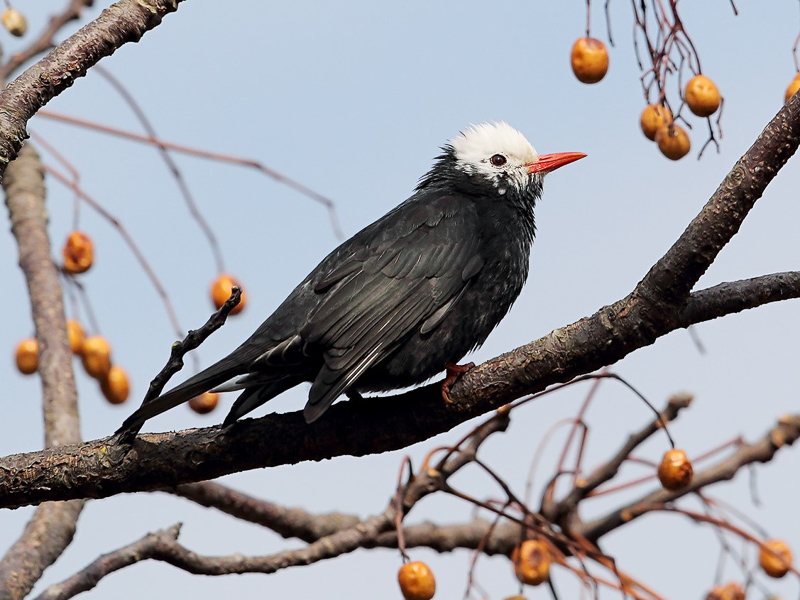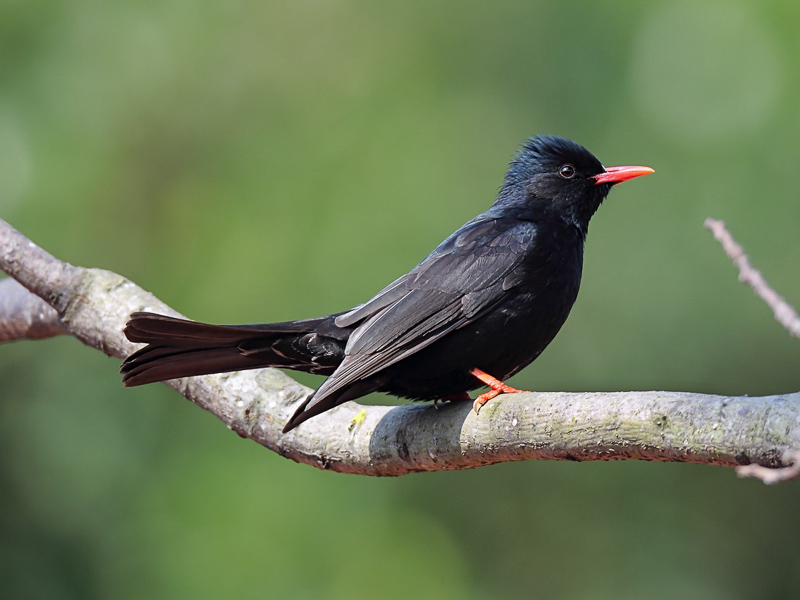Black Bulbul Hypsipetes leucocephalus 黑短腳鵯
Category I. Primarily an irruptive winter visitor and passage migrant to forest and shrubland, scarce in most winters. A small but increasing breeding population has recently become established in the central New Territories.
IDENTIFICATION

Jan. 2011, Michelle and Peter Wong. Adult.
A relatively large bulbul with a ragged, partially-erectile crest on the rear crown and a long distinctly-notched tail that appears square when spread. In the race occurring in HK, adults have a pure white head and upper breast; otherwise plumage usually appears entirely black, though it is actually very dark grey.

Feb. 2011, Michelle and Peter Wong. First-winter.
Juveniles and first-years early in the winter are entirely black with a brownish tinge. There is a body moult in late winter or spring, when birds with partly white heads may be seen. At least some birds are black-headed in their first summer (second calendar year); however, it is not clear whether all are. The iris is dark brown and the bill and legs are bright reddish-orange at all ages except for juveniles which have a black bill.
VOCALISATIONS
The song comprises the measured repetition of a limited variety of short rattles, buzzing notes and purer sounds.
A frequently heard call is three-note phrase in which either the first or the second element is higher-pitched than the remainder.
Also a distinctive dry mewing squeal.
DISTRIBUTION & HABITAT PREFERENCE
Wintering Black Bulbuls in HK are largely found in more mature forest, but passage migrants are more widespread, occurring in shrubland, on small islands and even urban parks, so long as large trees are present. The small, recently established, breeding population is confined to forest, especially at higher elevations.
Long-known as an irruptive winter visitor, the first suggestion that Black Bulbul might colonise HK as a breeding species came in 1997 when at least eight were seen in Tai Po Kau from 4 May to 3 June and three were seen at Tai Mo Shan on 31 May. However, other than likely ex-captive individuals, it was not recorded again in summer until July 2005, also at Tai Po Kau, followed by two at Ng Tung Chai on 18 August 2013. The first proof of breeding in HK came on 7 July 2015 when a juvenile was trapped in Tai Po Kau on 7 July. Since that year summer records from the central New Territories have been annual, mostly from Tai Lam CP, where up to three were seen in summer 2016, up to five in 2018, up to ten, with breeding confirmed again in 2019, and up to 43, again including juveniles, in 2020. Summer records during this period also came from Lam Tsuen Valley in 2016 and 2020, Tai Po Kau Headland in 2019 and Ng Tung Chai and Tai Tong CP in 2020, whilst early autumn records, again largely from the central New Territories, also seem likely to refer to dispersal of breeding, or at least summering, individuals. Black Bulbul was recorded in three central New Territories squares (0.2%) in the 2016-19 breeding atlas survey and 0.3% and 0.4% of squares in the 2001-05 and 2016-19 winter surveys, respectively.
OCCURRENCE
Black Bulbul was first recorded in HK on 4 March 1930 when one was seen at Pok Fu Lam. Whilst this was a lone bird, the next HK records concerned an irruption lasting from mid-January to the end of March 1936 when flocks were recorded on HK Island, Lam Tsuen Valley and Kowloon Hills (Herklots 1953). Herklots (1967) documented subsequent irruptions in March 1957, January to March 1960 and December 1962 to April 1963, whilst there were irruptions of varying size in eight winters from 1958 to 1984, with most occurring in late winter and early spring, especially February and March.
Subsequently, irruptions became less frequent, with only one invasion up to 1998. This occurred in 1992, albeit it was (and remains) the largest on record, with two influxes noted, in mid-February and late March, and peak counts of 200 at Mount Austin, 170 at Tai Po Kau and 110 at Shing Mun, with smaller flocks noted elsewhere.
Since 1998 Black Bulbul has been recorded annually, albeit only a handful of individuals have been noted in some years, with small-scale arrivals taking place in early 2001, 2007 and 2008, whilst a larger irruption from January to April 2011 produced the only three-figure counts of the period with 100 noted at Kwai Chung on 15 January and 225 (the highest count on record) at Mai Po on 19 February.
Chalmers (1986) gave extreme dates of occurrence of Black Bulbul of 29 November and 18 April, while the latest date (except for the summer records of 1997, discussed above) quoted by Carey et al. (2001) was 27 April. This trend towards later occurrence in spring has continued since 1998, with birds recorded in early May in most years. Whilst some of these late records, especially from the central New Territories, may be referrable to potential breeding birds, some birds, the latest of which was one on Po Toi on 12 May 2020, are clearly passage migrants.
BREEDING
The breeding ecology of Black Bulbul in HK does not appear to have been studied beyond observations of an adult carrying food on 1 June and a newly-fledged juvenile seen on 7 June.
BEHAVIOUR, FORAGING & DIET
Black Bulbul is highly sociable and is usually found in small, medium or large flocks, the latter in irruption years. Flocks largely keep to the middle and upper canopy in forests and are often first detected by their distinctive vocalisations, but Black Bulbuls are perhaps more inclined than Chestnut and Mountain Bulbuls to perch in the open on snags, dead trees or bamboos.
Black Bulbul is presumed to be an insectivore-frugivore, like other bulbuls in HK. Its diet is largely undocumented, but a photograph shows a bird holding a fruit of the common naturalised exotic tree, Persian Lilac Melia azedarach in its bill (eBird 2021).
RANGE & SYSTEMATICS
The range extends from eastern Afghanistan in the west, through Nepal and northeast India east through China and throughout southeast Asia south to southern Thailand and Vietnam (Fishpool and Tobias 2020). In China occurs from east Tibet and west Yunnan north and east to central Sichuan, Hubei and Anhui. Black Bulbul in the northern and eastern parts of China is a migratory summer visitor to the breeding range, but it is present in Yunnan, Guangxi and Guangdong throughout the year (Liu and Chen 2021).
There are ten subspecies, nine of which occur in China. Wintering and breeding birds in HK are of the nominate form, one of three white-headed races (the others are black-headed), which breeds in south Anhui, southern Hunan, and Zhejiang south to Guangdong, Guangxi and HK. As both white and black-headed birds are seen in HK, it was once thought that more than one race occurred, but it is now considered that all HK records are attributable to this form and that black-headed birds are not in full adult plumage (see above).
CONSERVATION STATUS
IUCN: Least Concern. Population trend stable.
Carey, G. J., M. L. Chalmers, D. A. Diskin, P. R. Kennerley, P. J. Leader, M. R. Leven, R. W. Lewthwaite, D. S. Melville, M. Turnbull and L. Young (2001). The Avifauna of Hong Kong. Hong Kong Bird Watching Society, Hong Kong.
Chalmers, M. L. (1986). Annotated Checklist of the Birds of Hong Kong. Hong Kong Bird Watching Society, Hong Kong.
eBird. 2021. eBird: An online database of bird distribution and abundance [web application]. eBird, Cornell Lab of Ornithology, Ithaca, New York. Available: http://www.ebird.org. (Accessed: 8 August 2021).
Fishpool, L. and J. A. Tobias (2020). Black Bulbul (Hypsipetes leucocephalus), version 1.0. In Birds of the World (J. del Hoyo, A. Elliott, J. Sargatal, D. A. Christie, and E. de Juana, Editors). Cornell Lab of Ornithology, Ithaca, NY, USA. https://doi.org/10.2173/bow.blabul1.01
Herklots, G. A. C. (1953). Hong Kong Birds. South China Morning Post, Hong Kong.
Herklots, G. A. C. (1967). Hong Kong Birds (2nd ed.). South China Morning Post, Hong Kong.
Liu, Y. and S. H. Chen (eds) (2021). The CNG Field Guide to the Birds of China (in Chinese). Hunan Science and Technology Publication House, Changsha.

